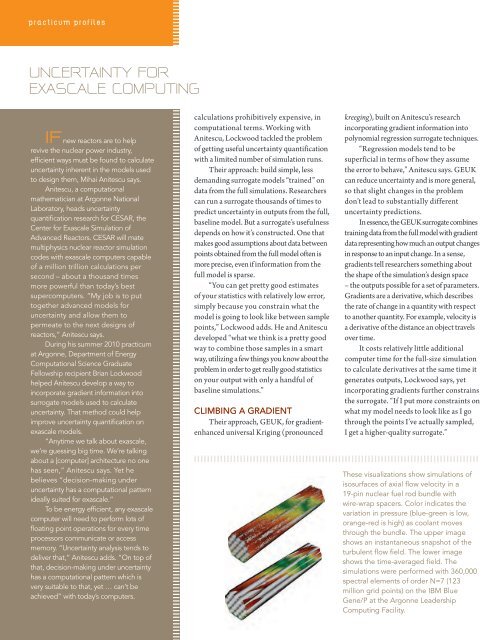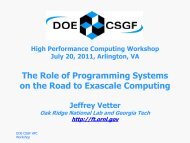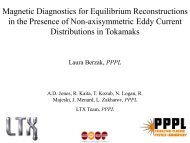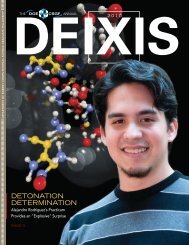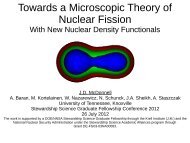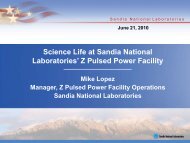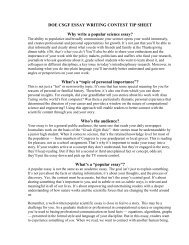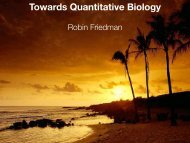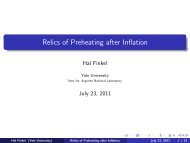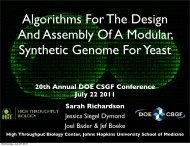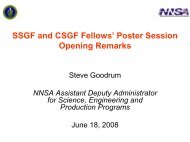2012 - Krell Institute
2012 - Krell Institute
2012 - Krell Institute
You also want an ePaper? Increase the reach of your titles
YUMPU automatically turns print PDFs into web optimized ePapers that Google loves.
practicum profiles<br />
UNCERTAINTY FOR<br />
EXASCALE COMPUTING<br />
IF new reactors are to help<br />
revive the nuclear power industry,<br />
efficient ways must be found to calculate<br />
uncertainty inherent in the models used<br />
to design them, Mihai Anitescu says.<br />
Anitescu, a computational<br />
mathematician at Argonne National<br />
Laboratory, heads uncertainty<br />
quantification research for CESAR, the<br />
Center for Exascale Simulation of<br />
Advanced Reactors. CESAR will mate<br />
multiphysics nuclear reactor simulation<br />
codes with exascale computers capable<br />
of a million trillion calculations per<br />
second – about a thousand times<br />
more powerful than today’s best<br />
supercomputers. “My job is to put<br />
together advanced models for<br />
uncertainty and allow them to<br />
permeate to the next designs of<br />
reactors,” Anitescu says.<br />
During his summer 2010 practicum<br />
at Argonne, Department of Energy<br />
Computational Science Graduate<br />
Fellowship recipient Brian Lockwood<br />
helped Anitescu develop a way to<br />
incorporate gradient information into<br />
surrogate models used to calculate<br />
uncertainty. That method could help<br />
improve uncertainty quantification on<br />
exascale models.<br />
“Anytime we talk about exascale,<br />
we’re guessing big time. We’re talking<br />
about a [computer] architecture no one<br />
has seen,” Anitescu says. Yet he<br />
believes “decision-making under<br />
uncertainty has a computational pattern<br />
ideally suited for exascale.”<br />
To be energy efficient, any exascale<br />
computer will need to perform lots of<br />
floating point operations for every time<br />
processors communicate or access<br />
memory. “Uncertainty analysis tends to<br />
deliver that,” Anitescu adds. “On top of<br />
that, decision-making under uncertainty<br />
has a computational pattern which is<br />
very suitable to that, yet … can’t be<br />
achieved” with today’s computers.<br />
P10 DEIXIS 12 DOE CSGF ANNUAL<br />
calculations prohibitively expensive, in<br />
computational terms. Working with<br />
Anitescu, Lockwood tackled the problem<br />
of getting useful uncertainty quantification<br />
with a limited number of simulation runs.<br />
Their approach: build simple, less<br />
demanding surrogate models “trained” on<br />
data from the full simulations. Researchers<br />
can run a surrogate thousands of times to<br />
predict uncertainty in outputs from the full,<br />
baseline model. But a surrogate’s usefulness<br />
depends on how it’s constructed. One that<br />
makes good assumptions about data between<br />
points obtained from the full model often is<br />
more precise, even if information from the<br />
full model is sparse.<br />
“You can get pretty good estimates<br />
of your statistics with relatively low error,<br />
simply because you constrain what the<br />
model is going to look like between sample<br />
points,” Lockwood adds. He and Anitescu<br />
developed “what we think is a pretty good<br />
way to combine those samples in a smart<br />
way, utilizing a few things you know about the<br />
problem in order to get really good statistics<br />
on your output with only a handful of<br />
baseline simulations.”<br />
CLIMBING A GRADIENT<br />
Their approach, GEUK, for gradientenhanced<br />
universal Kriging (pronounced<br />
kreeging), built on Anitescu’s research<br />
incorporating gradient information into<br />
polynomial regression surrogate techniques.<br />
“Regression models tend to be<br />
superficial in terms of how they assume<br />
the error to behave,” Anitescu says. GEUK<br />
can reduce uncertainty and is more general,<br />
so that slight changes in the problem<br />
don’t lead to substantially different<br />
uncertainty predictions.<br />
In essence, the GEUK surrogate combines<br />
training data from the full model with gradient<br />
data representing how much an output changes<br />
in response to an input change. In a sense,<br />
gradients tell researchers something about<br />
the shape of the simulation’s design space<br />
– the outputs possible for a set of parameters.<br />
Gradients are a derivative, which describes<br />
the rate of change in a quantity with respect<br />
to another quantity. For example, velocity is<br />
a derivative of the distance an object travels<br />
over time.<br />
It costs relatively little additional<br />
computer time for the full-size simulation<br />
to calculate derivatives at the same time it<br />
generates outputs, Lockwood says, yet<br />
incorporating gradients further constrains<br />
the surrogate. “If I put more constraints on<br />
what my model needs to look like as I go<br />
through the points I’ve actually sampled,<br />
I get a higher-quality surrogate.”<br />
These visualizations show simulations of<br />
isosurfaces of axial flow velocity in a<br />
19-pin nuclear fuel rod bundle with<br />
wire-wrap spacers. Color indicates the<br />
variation in pressure (blue-green is low,<br />
orange-red is high) as coolant moves<br />
through the bundle. The upper image<br />
shows an instantaneous snapshot of the<br />
turbulent flow field. The lower image<br />
shows the time-averaged field. The<br />
simulations were performed with 360,000<br />
spectral elements of order N=7 (123<br />
million grid points) on the IBM Blue<br />
Gene/P at the Argonne Leadership<br />
Computing Facility.


